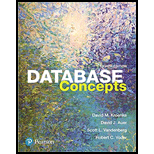
DATABASE CONCEPTS+MYITLAB
18th Edition
ISBN: 9780134821245
Author: KROENKE
Publisher: PEARSON C
expand_more
expand_more
format_list_bulleted
Question
Chapter 8, Problem 8.23RQ
Program Plan Intro
OLAP reports:
The reports that are generated after performing some basic arithmetic with the help of OLAP is called as OLAP report.
Note: OLAP stands for “Online Analytical Processing” which is a technology that is laid behind many Business Intelligence applications.
- OLAP report can also be called as OLAP cube.
Expert Solution & Answer
Want to see the full answer?
Check out a sample textbook solution
Students have asked these similar questions
In a shopping cart, there are various items, which can either belong to the category of household items or electronic items. The following UML diagram illustrates the relationship between items, household items, and electronic items.
//Implementation Class
public class ShoppingCart{
public static void main(String[] args){
final int MAX_ITEM = 50;
Item cart = new Item[MAX_ITEM];
addItem(cart); // populate the item array
printItem(cart);
}
}
Considering that all the data definition classes and the implementation class are complete, which of the following Object-Oriented Programming (OOP) concepts do you need to use in the above context?
i) Polymorphism
ii) Method Overloading
iii) Method Overriding
iv) Dynamic Binding
v) Abstract Class
Explain, using course terminology, how you would use any of the above concepts to model the given scenario.
Answer this JAVA OOP question below:
An Employee has a name, employee ID, and department. An Employee object must be created with all its attributes. The UML diagram is provided below:
- name: String - employeeId: String - department: String
+ Employee(name: String, employeeId: String, department: String) + setName(name: String): void + setEmployeeId(employeeId: String): void + setDepartment(department: String): void + getName(): String + getEmployeeId(): String + getDepartment(): String + toString(): String
A faculty is an Employee with an additional field String field: rank
public class TestImplementation{
public static void main(String[] args){
Employee[] allEmployee = new Employee[100];
// create an employee object with name Tom Evan, employee ID 001 and department IST and store it in allEmployee
// create a faculty object with name Adam Scott, employee ID 002, department IST and rank Professor and store it in allEmployee } }
Please answer this JAVA OOP question that is given below:
An Employee has a name, employee ID, and department. An Employee object must be created with all its attributes. The UML diagram is provided below:
- name: String - employeeId: String - department: String
+ Employee(name: String, employeeId: String, department: String) + setName(name: String): void + setEmployeeId(employeeId: String): void + setDepartment(department: String): void + getName(): String + getEmployeeId(): String + getDepartment(): String + toString(): String
A faculty is an Employee with an additional field String field: rank
Assuming the Employee class is fully implemented, define a Professor class in Java with the following:
A toString() method that includes both the inherited attributes and the specialization
Chapter 8 Solutions
DATABASE CONCEPTS+MYITLAB
Ch. 8 - Prob. 8.1RQCh. 8 - Prob. 8.2RQCh. 8 - Prob. 8.3RQCh. 8 - Prob. 8.4RQCh. 8 - Prob. 8.5RQCh. 8 - Prob. 8.6RQCh. 8 - What problems in operational data create the need...Ch. 8 - Prob. 8.8RQCh. 8 - Prob. 8.9RQCh. 8 - Prob. 8.10RQ
Ch. 8 - Explain the difference between a data warehouse...Ch. 8 - Prob. 8.12RQCh. 8 - Prob. 8.13RQCh. 8 - Prob. 8.14RQCh. 8 - Prob. 8.15RQCh. 8 - Prob. 8.16RQCh. 8 - Prob. 8.17RQCh. 8 - Prob. 8.18RQCh. 8 - Prob. 8.19RQCh. 8 - Prob. 8.20RQCh. 8 - Prob. 8.21RQCh. 8 - Prob. 8.22RQCh. 8 - Prob. 8.23RQCh. 8 - Prob. 8.24RQCh. 8 - Prob. 8.25RQCh. 8 - Prob. 8.26RQCh. 8 - Prob. 8.27RQCh. 8 - Explain one way to partition a database that has...Ch. 8 - Prob. 8.29RQCh. 8 - Explain what must be done when fully replicating a...Ch. 8 - Prob. 8.31RQCh. 8 - Prob. 8.32RQCh. 8 - Prob. 8.33RQCh. 8 - Prob. 8.34RQCh. 8 - Explain the meaning of the term object...Ch. 8 - Prob. 8.36RQCh. 8 - Prob. 8.37RQCh. 8 - Prob. 8.38RQCh. 8 - Prob. 8.39RQCh. 8 - Prob. 8.40RQCh. 8 - Prob. 8.41RQCh. 8 - Prob. 8.42RQCh. 8 - Prob. 8.43RQCh. 8 - Prob. 8.44RQCh. 8 - Prob. 8.45RQCh. 8 - Prob. 8.46RQCh. 8 - Prob. 8.47RQCh. 8 - Prob. 8.48RQCh. 8 - Prob. 8.49RQCh. 8 - Prob. 8.50RQCh. 8 - Prob. 8.51RQ
Knowledge Booster
Similar questions
- Please answer JAVA OOP question below: An Employee has a name, employee ID, and department. An Employee object must be created with all its attributes. The UML diagram is provided below: - name: String - employeeId: String - department: String + Employee(name: String, employeeId: String, department: String) + setName(name: String): void + setEmployeeId(employeeId: String): void + setDepartment(department: String): void + getName(): String + getEmployeeId(): String + getDepartment(): String + toString(): String A faculty is an Employee with an additional field String field: rank Assuming the Employee class is fully implemented, define a Professor class in Java with the following: Instance variable(s) A Constructorarrow_forwardDevelop a C++ program that execute the operation as stated by TM for addition of two binary numbers (see attached image). Your code should receive two binary numbers and output the resulting sum (also in binary). Make sure your code mimics the TM operations (dealing with the binary numbers as a string of characters 1 and 0, and following the logic to increase the first number and decreasing the second one. Try your TM for the following examples: 1101 and 101, resulting 10010; and 1101 and 11, resulting 10000.arrow_forwardI need to define and discuss the uses of one monitoring or troubleshooting tool in Windows Server 2019. thank youarrow_forward
- I would likr toget help with the following concepts: - Windows Server features - Windows Server versus Windows 10 used as a client-server networkarrow_forwardI need to define and discuss the uses of one monitoring or troubleshooting tool in Windows Server 2019. thank youarrow_forwardWhy is planning for the retirement system and transition critical?arrow_forward
arrow_back_ios
SEE MORE QUESTIONS
arrow_forward_ios
Recommended textbooks for you
 Management Of Information SecurityComputer ScienceISBN:9781337405713Author:WHITMAN, Michael.Publisher:Cengage Learning,
Management Of Information SecurityComputer ScienceISBN:9781337405713Author:WHITMAN, Michael.Publisher:Cengage Learning, Enhanced Discovering Computers 2017 (Shelly Cashm...Computer ScienceISBN:9781305657458Author:Misty E. Vermaat, Susan L. Sebok, Steven M. Freund, Mark Frydenberg, Jennifer T. CampbellPublisher:Cengage Learning
Enhanced Discovering Computers 2017 (Shelly Cashm...Computer ScienceISBN:9781305657458Author:Misty E. Vermaat, Susan L. Sebok, Steven M. Freund, Mark Frydenberg, Jennifer T. CampbellPublisher:Cengage Learning Principles of Information Systems (MindTap Course...Computer ScienceISBN:9781305971776Author:Ralph Stair, George ReynoldsPublisher:Cengage Learning
Principles of Information Systems (MindTap Course...Computer ScienceISBN:9781305971776Author:Ralph Stair, George ReynoldsPublisher:Cengage Learning
 Fundamentals of Information SystemsComputer ScienceISBN:9781337097536Author:Ralph Stair, George ReynoldsPublisher:Cengage LearningCOMPREHENSIVE MICROSOFT OFFICE 365 EXCEComputer ScienceISBN:9780357392676Author:FREUND, StevenPublisher:CENGAGE L
Fundamentals of Information SystemsComputer ScienceISBN:9781337097536Author:Ralph Stair, George ReynoldsPublisher:Cengage LearningCOMPREHENSIVE MICROSOFT OFFICE 365 EXCEComputer ScienceISBN:9780357392676Author:FREUND, StevenPublisher:CENGAGE L

Management Of Information Security
Computer Science
ISBN:9781337405713
Author:WHITMAN, Michael.
Publisher:Cengage Learning,

Enhanced Discovering Computers 2017 (Shelly Cashm...
Computer Science
ISBN:9781305657458
Author:Misty E. Vermaat, Susan L. Sebok, Steven M. Freund, Mark Frydenberg, Jennifer T. Campbell
Publisher:Cengage Learning

Principles of Information Systems (MindTap Course...
Computer Science
ISBN:9781305971776
Author:Ralph Stair, George Reynolds
Publisher:Cengage Learning


Fundamentals of Information Systems
Computer Science
ISBN:9781337097536
Author:Ralph Stair, George Reynolds
Publisher:Cengage Learning

COMPREHENSIVE MICROSOFT OFFICE 365 EXCE
Computer Science
ISBN:9780357392676
Author:FREUND, Steven
Publisher:CENGAGE L